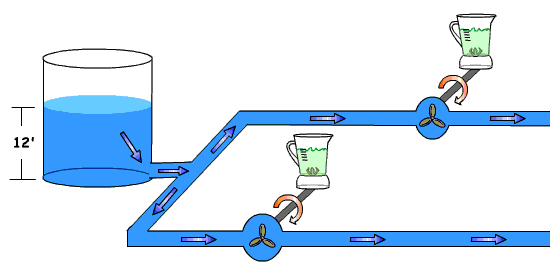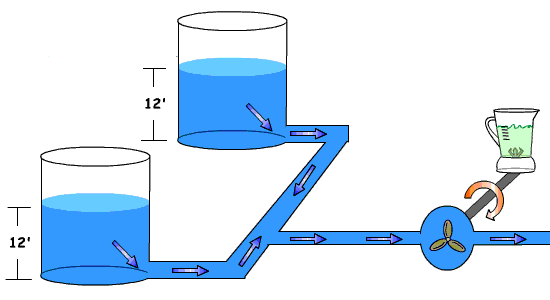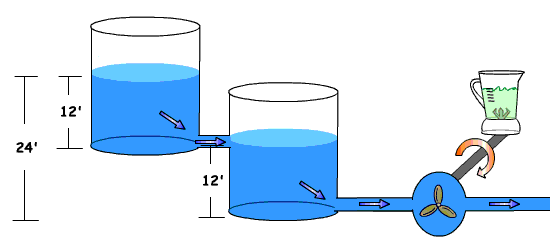Sophivorus (talk | contribs) No edit summary |
|||
| Line 1: | Line 1: | ||
Some basic definitions, equations and analogies of electricity. | Some basic definitions, equations and analogies of electricity. | ||
==Definitions== | == Definitions == | ||
{| class=wikitable | | {| class=wikitable | | ||
! | ! | ||
| Line 12: | Line 13: | ||
|---- | |---- | ||
!Voltage | !Voltage | ||
| | | V | ||
|volt (V) | |volt (V) | ||
|Pressure (Potential) difference due to charge difference | |Pressure (Potential) difference due to charge difference | ||
|Head: Pressure (Potential) difference due to height difference | |Head: Pressure (Potential) difference due to height difference | ||
| J/C | | J/C | ||
| kg•m²/(s³•A) | | kg•m²/(s³•A) | ||
|---- | |---- | ||
!Current | !Current | ||
| | | I | ||
|amp (A) | |amp (A) | ||
|Flow of charge in charge/time or coulombs/sec | |Flow of charge in charge/time or coulombs/sec | ||
|Flow: Flow of water in volume per time such as liters/sec | |Flow: Flow of water in volume per time such as liters/sec | ||
| C/s or W/V | | C/s or W/V | ||
| A | | A | ||
|---- | |---- | ||
!Resistance | !Resistance | ||
| | | R | ||
|ohm (Ω) | |ohm (Ω) | ||
|Opposition to the flow of charge | |Opposition to the flow of charge | ||
| Line 36: | Line 37: | ||
|---- | |---- | ||
!Power | !Power | ||
| | | P | ||
|watt (W) | |watt (W) | ||
|Energy/Time also Power=Current (I) * Voltage (V) | |Energy/Time also Power=Current (I) * Voltage (V) | ||
| Line 44: | Line 45: | ||
|---- | |---- | ||
!Energy | !Energy | ||
| | | E | ||
|watt-hour (Wh) | |watt-hour (Wh) | ||
|The ability to do work | |The ability to do work | ||
| Line 53: | Line 54: | ||
|} | |} | ||
==Equations== | == Equations == | ||
;P=IV | ;P=IV | ||
:Power=Current*Voltage | |||
:look familiar, see [[:Category:Microhydro#Equation|P=Q*H*e/k from microhydro power]] | : Power=Current*Voltage | ||
: look familiar, see [[:Category:Microhydro#Equation|P=Q*H*e/k from microhydro power]] | |||
;V=IR | ;V=IR | ||
:Volts=Current*Resistance | |||
:I=V/R might be more edifying since current is usually the result of pressure acting on resistance. | : Volts=Current*Resistance | ||
:This only applies to [[ | : I=V/R might be more edifying since current is usually the result of pressure acting on resistance. | ||
: This only applies to [[Wikipedia:Ohm's law|ohmic circuits]], those circuits which display a linear relationship between current and voltage (i.e. the resistance does not change based upon current or voltage). | |||
{| class=wikitable align="center" | {| class=wikitable align="center" | ||
| Line 79: | Line 82: | ||
|} | |} | ||
==Analogies== | == Analogies == | ||
The following animated analogy illustrates the operation of direct current (DC) circuits. | |||
The following animated analogy illustrates the operation of direct current (DC) circuits. | |||
{| class=wikitable align="right" | {| class=wikitable align="right" | ||
| Line 87: | Line 91: | ||
! Component !! Analog | ! Component !! Analog | ||
|- | |- | ||
| Tank || Battery | | Tank || Battery | ||
|- | |- | ||
| Tank Vertical Difference || Battery Voltage Difference | | Tank Vertical Difference || Battery Voltage Difference | ||
| Line 99: | Line 103: | ||
For each example, ask yourself: | For each example, ask yourself: | ||
*How fast will the battery run out? | |||
*How fast will the virgin margaritas be made? | * How fast will the battery run out? | ||
*And most importantly why? | * How fast will the virgin margaritas be made? | ||
* And most importantly why? | |||
If you would like to do math to support these analogies, use: | If you would like to do math to support these analogies, use: | ||
===1 Tank 1 Blender=== | * Feet = volts | ||
* GPM = amps | |||
* Each blender has a resistance of 6 Feet/GPM = 6 ohms | |||
=== 1 Tank 1 Blender === | |||
[[File:Series 1T1B.gif]] | |||
===1 Tank 2 Series Blenders=== | * This is the test case (datum). | ||
[[ | |||
=== 1 Tank 2 Series Blenders === | |||
[[File:Series 1T2B.gif]] | |||
Notice that: | Notice that: | ||
===1 Tank 2 Parallel Blenders=== | * The flow is 1/2 the speed of our test case. | ||
[[ | * The two blenders in series are each going 1/4th the speed of our test case. | ||
=== 1 Tank 2 Parallel Blenders === | |||
[[File:Parallel 1T2B.gif]] | |||
Notice that: | Notice that: | ||
===2 Parallel Tanks 1 Blender=== | * Each blender is at the same speed as our test case. | ||
[[ | * The flow from the tank is twice as fast as our test case. | ||
=== 2 Parallel Tanks 1 Blender === | |||
[[File:Parallel 2T1B.gif]] | |||
Notice that: | Notice that: | ||
===2 Series Tanks 1 Blender=== | * The blender is the same speed as our test case. | ||
[[ | * The flow from each tank is half as fast as our test case. | ||
=== 2 Series Tanks 1 Blender === | |||
[[File:Series 2T1B.gif]] | |||
Notice that: | Notice that: | ||
*The blender is 4 times the speed as our test case. | |||
*The total flow is twice the speed as our test case. | * The blender is 4 times the speed as our test case. | ||
* The total flow is twice the speed as our test case. | |||
PS The second tank has a lid that keeps it closed. | PS The second tank has a lid that keeps it closed. | ||
==Background Essentials== | == Background Essentials == | ||
See [[Rural Electrification Systems]] for more background information (these page should be integrated together). | See [[Rural Electrification Systems]] for more background information (these page should be integrated together). | ||
== External links == | == External links == | ||
*http://cnx.org/content/m1000/latest/ | * http://www.batteryfaq.org/ | ||
:Understanding current | : Everything you every wanted to know about Lead Acid batteries. | ||
: Car and Deep Cycle Battery FAQ | |||
* http://hyperphysics.phy-astr.gsu.edu/hbase/electric/dccircon.html#c1 | |||
: Fantastic site on physics in general. Easy to understand, but accurate information on DC Circuits. | |||
: HyperPhysics - DC Circuits | |||
* http://library.thinkquest.org/10796/ch11/ch11.htm | |||
: Some easy to follow basic theory. | |||
: Lesson 3: Electricity - Colegio Franklin Delano Roosevelt | |||
* http://science.howstuffworks.com/electricity.htm | |||
: Some more information on electricity. Not wrot with error like at least one of their other pages. | |||
: How Stuff Works - Electricity | |||
* http://cnx.org/content/m1000/latest/ | |||
: Understanding current | |||
== See also== | == See also == | ||
* [[Low voltage connection basics]] | |||
* [[Power and energy basics]] | |||
[[Category:Electricity]] | [[Category:Electricity]] | ||
Revision as of 17:43, 25 September 2020
Some basic definitions, equations and analogies of electricity.
Definitions
| Symbol | Unit | Description | Water Analog | Elec. Units | Base Units | |
|---|---|---|---|---|---|---|
| Voltage | V | volt (V) | Pressure (Potential) difference due to charge difference | Head: Pressure (Potential) difference due to height difference | J/C | kg•m²/(s³•A) |
| Current | I | amp (A) | Flow of charge in charge/time or coulombs/sec | Flow: Flow of water in volume per time such as liters/sec | C/s or W/V | A |
| Resistance | R | ohm (Ω) | Opposition to the flow of charge | Friction: Opposition to the flow of water | V/A | kg•m²/(s³•A²) |
| Power | P | watt (W) | Energy/Time also Power=Current (I) * Voltage (V) | Power: Power=Flow (Q) * Pressure (H) | J/s or A•V | kg•m²/s³ |
| Energy | E | watt-hour (Wh) | The ability to do work | Energy: The ability to do work | 3600 J | kg•m²/s² |
Equations
- P=IV
- Power=Current*Voltage
- look familiar, see P=Q*H*e/k from microhydro power
- V=IR
- Volts=Current*Resistance
- I=V/R might be more edifying since current is usually the result of pressure acting on resistance.
- This only applies to ohmic circuits, those circuits which display a linear relationship between current and voltage (i.e. the resistance does not change based upon current or voltage).
| Series | Parallel |
|---|---|
| VT=V1+V2+… | V stays same |
| I stays same | IT=I1+I2+… |
| RT=R1+R2+… | 1/RT=(1/R1)+(1/R2)+… |
Analogies
The following animated analogy illustrates the operation of direct current (DC) circuits.
| Water Tank - Electricity Analogy | |
|---|---|
| Component | Analog |
| Tank | Battery |
| Tank Vertical Difference | Battery Voltage Difference |
| Water Flow | Electrical Current |
| Mechanical Energy Appliance (Blender) | Electrical Energy Appliance |
| Power=Head*Flow | Power=Voltage*Current |
For each example, ask yourself:
- How fast will the battery run out?
- How fast will the virgin margaritas be made?
- And most importantly why?
If you would like to do math to support these analogies, use:
- Feet = volts
- GPM = amps
- Each blender has a resistance of 6 Feet/GPM = 6 ohms
1 Tank 1 Blender
- This is the test case (datum).
1 Tank 2 Series Blenders
Notice that:
- The flow is 1/2 the speed of our test case.
- The two blenders in series are each going 1/4th the speed of our test case.
1 Tank 2 Parallel Blenders
Notice that:
- Each blender is at the same speed as our test case.
- The flow from the tank is twice as fast as our test case.
2 Parallel Tanks 1 Blender
Notice that:
- The blender is the same speed as our test case.
- The flow from each tank is half as fast as our test case.
2 Series Tanks 1 Blender
Notice that:
- The blender is 4 times the speed as our test case.
- The total flow is twice the speed as our test case.
PS The second tank has a lid that keeps it closed.
Background Essentials
See Rural Electrification Systems for more background information (these page should be integrated together).
External links
- Everything you every wanted to know about Lead Acid batteries.
- Car and Deep Cycle Battery FAQ
- Fantastic site on physics in general. Easy to understand, but accurate information on DC Circuits.
- HyperPhysics - DC Circuits
- Some easy to follow basic theory.
- Lesson 3: Electricity - Colegio Franklin Delano Roosevelt
- Some more information on electricity. Not wrot with error like at least one of their other pages.
- How Stuff Works - Electricity
- Understanding current




